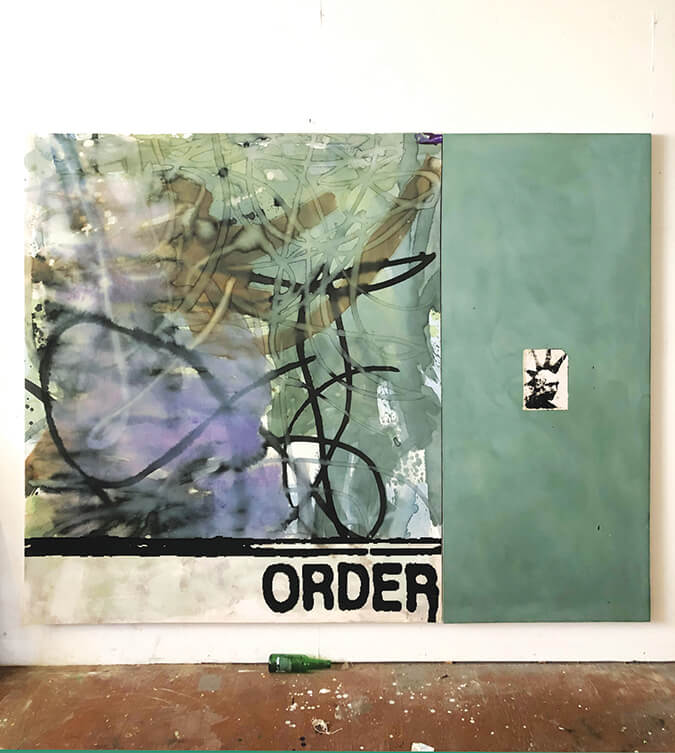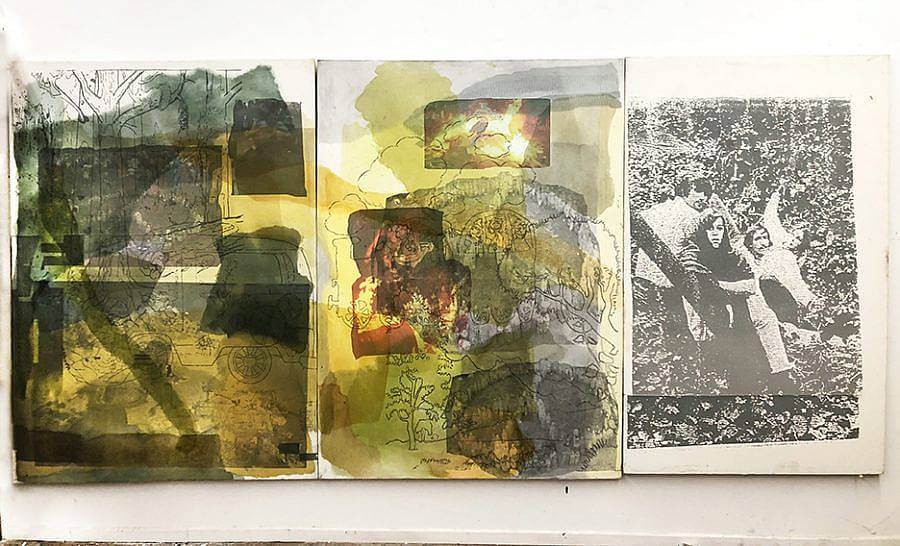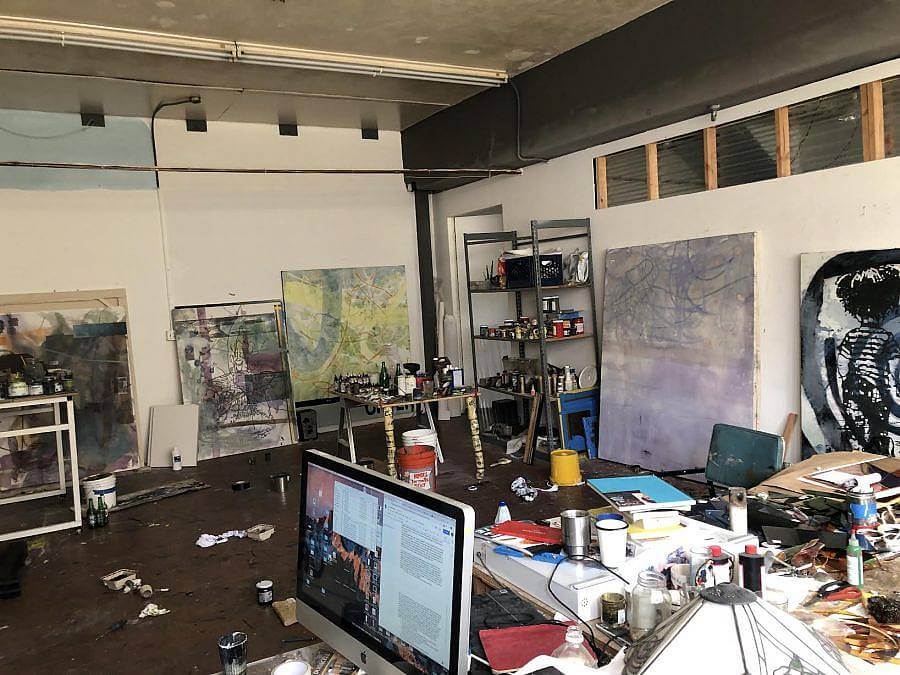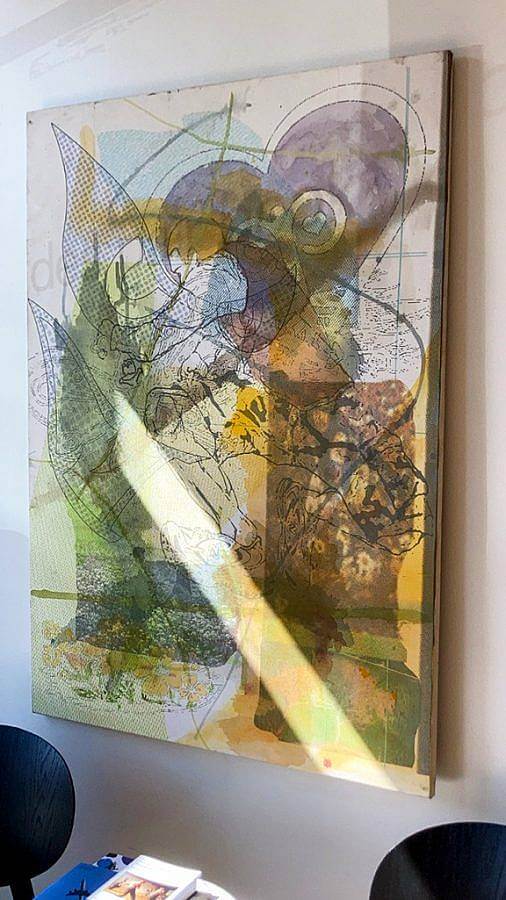Tell us a bit about yourself and what you do.
Hey. Thanks for hitting me up to do this interview. To be honest, I’ve had a strangely hard time trying to write all this. I’ve read through and changed these answers damn near 15 times, because I’ve been trying to figure out how to talk about myself and my practice in a way that feels more straight up, real, like a casual conversation. A conversation where I’m working out, on the fly, why my practice is relevant to me, who/what has informed my work, how I find importance within my own work, and why the fuck I even make these things. I could give you some sort of strictly academic formal writing pulled 1:1 from lost college notebooks, to notes I’ve scribbled on the back of takeout receipts about my work. I know the language, yet that’s not how I want to do this. That would seem so declarative. It would, and this might seem harebrained, come off as I really know what I’m doing and that I have all of this figured out. Which isn’t true. I have ideas, but I contradict them at will. Then I’ll probably contradict the contradictions. I try to think like run-on sentences. Always hoping to type a period and end the thought. Yet how am I supposed to let the sentence end at 25 years old? I’ve written this out trying to figure out a voice to represent the sort of honesty in a casual conversation. The sort of casualness that can easily be lost while trying to explain yourself and your art in a public piece of writing. As I’ve reread my answers I can also see how this could make me come off like a complete fucking jackass (which needless to say wasn’t necessarily the goal either).
With all of that being said, I don’t take myself too seriously. However, I give a fuck about what I do, so I’m bound to ramble about it. I currently live and work in Los Angeles California. I guess I’m a painter. “I guess” really isn’t needed in that statement; without a doubt I’m a painter. There was probably a point and time that I thought of myself as an interdisciplinary artist, but as the years have gone by, painting has persisted as my main focus. I’m also full of shit, cause I do make sculptures or, I guess I’d like to think that it’s a part of my practice. Ok here it is, painting is at the forefront of my practice with elements of sculpture appearing late in the stages of making a body of work, usually revealing themselves at the time of installing a show. The paintings deal with ideas around network painting, feedback loops, pop/sub cultural histories, post-structuralist thinking, and overtly romantic ideologies. In terms of myself, I talk – sometimes too much, sometimes saying things I shouldn’t, and sometimes at all the wrong times. This feels like I’m filling out a dating app Q&A. Does this sound weird? Fuck. We’re just going to move on to the next question.
What made you want to become an artist?
That’s a funny one, cause for me there was never some early moment that was like ‘oh yeah, this is it’. There was no ‘oh I drew pictures when I was five and it just stuck’. I think I could better answer, ‘why do you want to be an artist?’ Cause that question is always being defined and redefined the longer I do this. There’ve been shows that I’ve seen that have absolutely rocked me. I mean really floored me and broke expectations of how you can make work and what it can do. I guess the real big one for me earlier on was this Albert Oehlen mid-career survey show at the New Museum in 2015. It crushed me. It was a major lightbulb moment that really thrusted me into what a contemporary painting show could look like, how it could operate in its space, and refer beyond its condition of being stuck in that room. But you know, these things have happened and they still happen – walking into any show, it has the potential to have that effect. That’s probably why I do this. It’s to try to deal with the impossible, never-ending attempt to find an alternative to how paintings can function. You can choose to look at painting as a vehicle to refer to the world and how it wrestles with its stationary position in that world. This is totally an idealistic take on it all, but it’s a space I try to keep my mind in. Without that mental approach I’d fall into total cynicism about participating in the art world. Some other shows that had that lightbulb effect would be the Chris Martin show at David Kordansky in 2016, the four Sigmar Polke paintings on the German Post-war painters floor at SFMOMA, the recent Joan Mitchell retrospective at SFMOMA – oh, and that Isa Genzken show at Hauser and Wirth LA from a few years ago. Conversations with peers or teachers of mine earlier on in my introduction to art also had a similar effect on me. Ok, this is probably getting a bit too lengthy so I guess we’ll just go to the next question.

Are you from Los Angeles originally? How has living there affected your work?
I am not originally from Los Angeles. I grew up in a very small rural farming town called Cachagua. It’s located in central California on a ridge that separates the Big Sur coast and the Salinas valley. I moved to Los Angeles in 2014 to go to UCLA and I’ve stayed here since. I think a lot about the city that I live in and how that might run off into my work. I mean, being in a major city you have a finger on the pulse with what is happening in the art world – for a lack of better words, what is ‘in’. Being in the media capital of the world you get to see the ‘pop’ element of what is ‘in’. All of this is ever-present in Los Angeles, but I don’t necessarily think that what I’m making is influenced by these things nor do I really see myself in these conversations. These are just observations I get to make about my surroundings, and how this relates to the world at large. At the same time, my foundations of education, experience and community within art were all in Los Angeles, and I’d be kidding myself if I said those things haven’t shaped how I think about and make work. In the big picture I don’t see myself as a Los Angeles lifer. At some point I’d like to leave the city. You know, do that painter thing and work ‘upstate’ as they say, or at least whatever the California equivalent of the Hudson valley studio would be. Still trying to figure that one out.

Can you talk about the work and exhibition design of your solo show “Every Good DeadHead is a Dead Head That’s Dead (Teen Idols)”?
So that was a show I did down in San Diego in 2020, right before the world screeched to a halt and went into lockdown. For this it makes the most sense to just pull some stuff out of the press release that I wrote for the show. Maybe that’s a bit of a cop out, but eh, I think it’s ok. More or less, it was a body of work that I had been working on since around 2016. The whole show’s starting point was given in the title of the show. “Every Good DeadHead is a Dead Head That’s Dead” Is a song by the Teen Idles. They were an early DC hardcore band fronted by Ian MacKaye who would later start the bands Minor Threat, Embrace, and Fugazi, yada yada you got the point. In the song there is a section where they cover a part of the Grateful Dead’s, “Casey Jones.” I thought this was the strangest structure to take on; so indulgent, and self reflective upon the Teen Idles point of departure and rejection of their previous precursor generation. The following are excerpts from the press release:
“In this whole equation the ‘re’ in history is vital. A tool to reconstruct, reevaluate, and reposition where we fit in. A reactionary attempt to curb the youths’ existentialism of finding the ‘proper’ mode of creating oneself in each given context.”
“The work dances with the eyes of its onlookers in a hall of mirrors. A hall of mirrors that only reflect the very ones darting their stares. It delivers fragments and pieces of the viewer themselves. Sort of unconscious associations of “I wore flannels and blue jeans three years ago, I guess I wore tiedye a year ago” — not subject to further consideration, no questioning why. The meaning is not in its historical underpinning but rather in the visual language of associations that play out. It’s the cast of a lens inward rather than outward. Inward in the sense that, through the works, we’ve been dealt the tools of re-viewing ourselves and our active participation within a sort of mass cultural obsession with forcing dead objects to rise, walk and talk once again. Isn’t that what a painting is trying to do? It’s confrontational through its romanticism of these histories. Bewitched by these histories, maybe? But also it’s a looking back to inform how we look forward, in this case, all while one’s eyes participate in the same thing it tries to reject.”
“the work engages with a new moment altogether — that of recreated moments looking back at their dead selves. This plays out time and time again, like a loop that proposes time is not as linear as we would think it to be. It’s the psychedelic at play, emerging from the warpings of such reproductions. The psychedelic not in it’s adjective state, as in “hey mannnn that’s a pretty psychedelic painting”. Rather it is the psychedelic in its state as a moment, and in the ways that these moments (past and present, conscious and subconscious) collide, interact and re-form obscurely with time. “
Long story short, I was trying to find certain feedback loops that occurred within visual representations of certain historicized subcultures. In this case, the main two points of reference were Woodstock 69 and Woodstock 99. I was trying to understand a multi-generational obsession (myself included) with cultural nostalgia and the adoption of certain visual motifs without the politics they once held. Basically just identifying that these loops occur, and trying to figure a way in which that system of looping could be applied to the mechanics of how I made a painting. I’m sort of haunted by this body of work. It took a whole lot of time after the show to get things rolling again, but I guess that’s sort of a personal problem and doesn’t at all pertain to the question.


What have you been reading lately?
Roberto Bolano – The Savage Detectives
Barbara Krueger – Remote Control
Arthur Rimbaud – Anthology
Isabelle Graw – For The Love Of Painting
Jean Genet – Miracle Of The Rose
Jimmy McDonough – Shakey Biography of Neil Young
I’m a spastic reader I have a bunch of other books I’ve started, but like are always in a state of reading for a little putting it down picking something up sort of thing, but those six books are in the rotation.
How did you begin designing band posters and album covers?
My introduction to contemporary art was probably through old Pettibon flyers. I used to play in some noise rock bands (Swarm) in college, and a kind of silly but extremely entertaining sort of hippie free noise band (Prairie) after I graduated. I think at a certain point I enjoyed making the flyers for the shows more than I actually enjoyed playing the shows. Or maybe I realized I was better at making a flyer than I was at making music. I stopped getting asked to play shows, and just started getting hit up more to make flyers. The flyer making kinda just stuck. It’s just something I do. It’s not something I take all that seriously. I would not call myself a designer or anything like that. A fun hobby.
Also to be noted neither of those bands have any recorded music on the internet.

Who has been influencing your work lately?
Michel Majerus, Brice Marden, Joan Mitchell, Barbara Krueger, Helen Frankenthaler, Albert Oehlen , and Julia Wachtel.
You have written about “coded systems within visual language”, could you elaborate on the way that this notion pertains to your work?
Oh ya. I mention that in that press release for “Every Good Deadhead Is A Deadhead That’s Dead.” Looking at specific sub-cultural and pop-cultural movements we see very specific homogenous visual elements that carry over a mass amount of participants in those movements. I mean if you look at when the Beatles broke out the haircut became so idefiable with…The Beatles. The Beatles cut, also known as the mop top. The mop top both identified John, Paul, George, and Ringo as the Beatles, but it also identified a whole generation of kids that, like a line of code being copy and pasted, carried a very specific declaration of intention. We saw that haircut resurge decades later, and it’ll probably resurge again at some point. The coded system being the history that plays out and how what remains is our ability to locate the ‘look’ of something as this or that or that or this relating to scene A, subculture B, and so on and on and on. How this pertains to my work is that the event that plays out in the work is rather an assumption of what one believes is the event because of the look of something, not necessarily the actual event. Or at least something along those lines.

What does your studio like?
Well… it’s in an absolute mess at the moment. I’m going to try to clean it up a little before I send you a photo of it. It’s a live/work situation. It’s an old warehouse built in the 30’s that hasn’t really been renovated or built out since then. I’m the only person who lives and works here, so it’s not one of those huge studio complexes, which is good for me. It’s separated into three different spaces. The first one is a storage zone, the second is my living space, and the third is my studio. The whole space is somewhere in the 1300sq ft range. The second to third zones have a wall with a door. The door between these two zones is crucial. It’d feel a lot different without it. I close the door and I’m not in my living space anymore. It’s so simple on paper, but psychologically it’s huge. There are windows that run the entire east side of the space. My partner and I made a 15ft stained glass mural in the living zone. The light shines from the east, so in the mornings it really does feel divine. I get this beautiful light as it breaches the horizon, and it’s thrilling. The room explodes from dark to very bright multicolored light in a matter of minutes. I become so aware of the light that I’m in here, and spend so much of that first hour in the morning just watching the light. I work in natural light as much as I can. I know when the light is perfect, I revel in it, obsess over it. It’s impossible to recreate this sort of moment, but the pigment is all activated by light ever changing with the dips and rises of brightness in the studio. The painting has all these variations of tones and hues that occur throughout the day without me even touching it with my brush. Of course all the pigment would pop more with the floodlights on, but I don’t know, the natural light is pure. It’s just another element to deal with. There’s also that whole romantic appeal, to think about the histories of painters and their dealings with natural light. I can totally recognize it’s a bit over the top, but once again it seems… pure.

Your paintings are typically very visually layered, how do you usually go about selecting and organizing the elements of the compositions?
I have two different bodies of work going in the studio at the moment. One that seems more associated with your question and another that I’ve recently started figuring out (which is actually doing something quite at odds with what you’re describing). In the more layered work, there are three main elements of production that are dealt with. Myself (applying paint with a brush), a computer (photoshop) and a printer (epson pro 9880). In a whole lot of ways the printer does a majority of the labor to ‘layer’ the look of the painting. I mean it doesn’t take many prints overlapping one photo on top of another with a line drawing running through to create a dense look. The operation of photoshop and applying paint with a brush is where things get interesting for me. I’d like to think I have a lexicon of moves that I make with paint; these moves are replicated and picked and pulled from other paintings again and again and again. If you look at the work all in the same room, you’ll pick out these recurring painted decisions, but they’re not 1:1. A swooping gesture that runs from top to bottom and then along the edge might be used in one painting and then used in another, but mirrored or running in reverse. It’s almost like using the transform scale feature on photoshop and twisting a shape, so that it’s horizontal instead of vertical. Am I making sense here? It’s using the basic tools of how you might lay out a photoshop document, but just applying that to using paint. The paintings then begin to develop as such. I mean they’re funny paintings. I keep calling them ‘landscapes’. They’re really not, but they are in some ways. They might start with a drawing pulled from an old punk fanzine of someone slam dancing, then that’s printed out onto canvas and the scene begins to hazily build from there. A patch of flowers might be printed and so forth, and now that’s a kind of funny dancing in flowers scene. All these source images have been totally yanked out of their origin and are recontextualized to make a ‘landscape’ painting. I guess when I call them landscapes it’s the same kind of way an Abex painter would call their non-representational painting a landscape. At the very least it’s informed by a landscape.
For this other body of work, it’s been a long process to try to simplify the approach and the systems of how the paintings operate. For a long time I’ve been wanting to open up my practice, expand but also simplify. Tools that have been vital for my work in the past (ie the printer, the computer) are playing lesser roles in this new body of work. I think the paintings are definitely a bit indulgent in certain histories of painting, specifically 50’s 60’s American Abstraction. I’m allowing myself to have these references to come out in the work. It’s some attempt trying to get away from these rigid restraints of what I thought or should do in the work. I say all this, but would still like to think that they still operate with the same sort of cool reserve that maybe is more located in conceptual art. It’s still trying to follow a hard system that begins with a predefined move and ends with another predefined move, but how it gets from these two points is unknown. Something that’s still present in this one, like the previous, is that they reach outside it’s frame of objecthood. As in the work is still reaching for something that is informed outside the space of its inherent history of painting.This body of work is dealing with ideas around the double portrait. It’s all an attempt to break down the ‘look’ of an abstract painting and I guess personifying it to be representative of an iconic cultural ‘look’ I.E. How is an abstract painting also a free love hippie? There’s a system that can be seen within how we categorize something as this or that. While the problems that happen in the work seem very formal, it’s through these formal decisions that dictate who the portrait is. Once again how are these things vehicles to the real world? What’s occurring within these quasi abstract paintings and who is/what is informing them? To riff off a quote said by Joan Mitchell, I want this work to be 19th century. Not in its look, but in its development. Small changes over the course of a very long time. Fuck, I don’t know this work is so new to me I’m still wording it out so you just gotta bear with me on this. I got a little carried away with this question. I’m over explaining and I’m talking too much.

What do you have planned for 2022?
At the moment there are a couple of group shows that I’m supposed to be in that have yet to be announced. Painting. I feel excited to be in my studio at the moment. It feels like I’m having a good stretch in here. Which isn’t always the case. In the past I’ve gone damn near six months without having a good day in the studio. So to have weeks where things feel exciting is a blessing. I get a little superstitious when I’m feeling like this in my studio. If I feel like I’m on a hot streak I start building these strange routines or habits. For example last week there was a three day stretch where things were really landing so I wore the same thing everyday. I mean I’m talking I slept in these clothes. Drank the same amount of coffee, ate the same thing that I did on that first day. I’ve written Paint Forever Live Forever on some sort of surface in every studio I’ve had. Stuff like that. Probably try to paint outdoors more. I’ve been strapping these big paintings on the top of my car and driving to remote spots and just painting out of the studio. Not representational plein air paintings, but just painting for painting’s sake. I guess to wrap it up, thanks for having me. I hope this sort of answers your questions. These things can be difficult, but I want them to continuously be in motion moving forward. I always want to move forward. Have a beautiful day.
Interview conducted and composed by Sam Dybeck.
